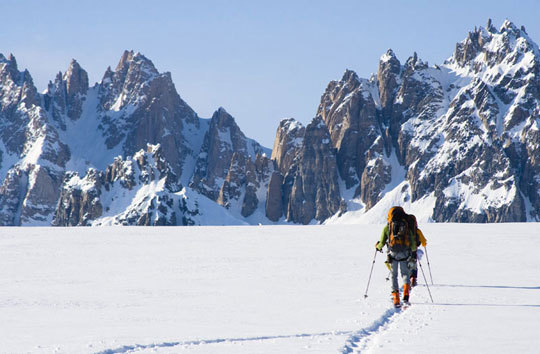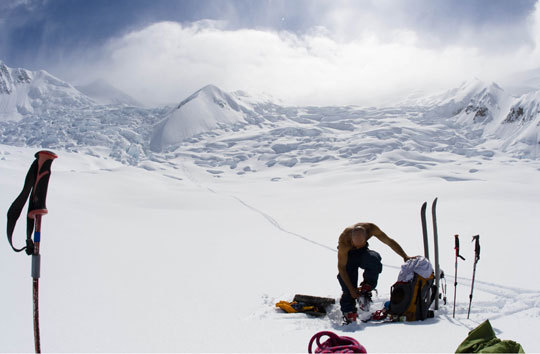
Andrew Wexler (leading) and Dylan Taylor reaching a 4,500-foot pass between the Capps and Triumvirate Glaciers, Tordrillo Mountains, Alaska. With Joe Stock, the team skied 100 miles, south to north, making a traverse of the entire range in that direction from May 16-25. [Photo] Joe Stock
Editor’s Note: Alaska’s Tordrillo Mountains are located west-northwest of Anchorage at the southern end of the Alaska Range. As the crow flies, the Tordrillos stretch ca. 65 miles south to north. The 100-mile traverse that climbs that terrain had been attempted last year by Joe Stock of Anchorage, Alaska and Andrew Wexler of Canmore, Alberta. This year Dylan Taylor of Bellingham, Washington accompanied them from May 16-25 to complete the traverse. Stock’s trip report is published below.
Although they summited the four highest mountains in the range, Stock and company bypassed Mt. Nagishlamina (11,068′), the fifth highest. Though reaching the summit of Nagishlamina would be easy from the south, Stock said, logically connecting it on the traverse to Mt. Torbert would require easy mixed and fifth-class climbing. Though tempted to try it, the team had only a short rope and no pickets or other climbing gear, so they skirted the peak via a 4,000′ icefall down the Southeast Cirque of the Capps Glacier on the east side of Nagishlamina. The more technical traverse including Nagishlamina still waits.
Since Chugach Powder Guides embedded a lodge in the range, the area has become famous for its accessible, quality heli-skiing. “The mountains are getting all this publicity from talented ski athletes,” Stock said, “but these mountains need more exposure from mountaineers who are approaching the range on more fair terms.”

Wexler on the Capps Glacier after descending the 4,000-foot Southeast Cirque icefall from the Spurr Plateau. This descent allowed the team to bypass technical terrain between Mt. Nagishlamina and Mt. Torbert. [Photo] Joe Stock
Over nine days in May 2008 Andrew Wexler and Dylan Taylor and I made a 100-mile, full-length ski traverse of the Tordrillo Mountains in Alaska. Our traverse traveled from south to north through the Tordrillos, climbing 38,000 vertical feet and making ski descents off the four highest peaks including Mt. Spurr (11,069′), Mt. Torbert (11,413′), Mt. Talachulitna (11,150′), and Mt. Gerdine (11,258′).
The Tordrillos are well-documented in Tordrillo–Pioneer Climbs and Flights in the Tordrillo Mountains of Alaska, by Rodman Wilson and Paul Crews Sr. The most significant traverse in that book was by the burly team of Scott Woolums and Mark Jonas in March 1982. Aiming for tower climbing in the Kichatna Mountains, they left from Beluga Lake, climbed the Triumvirate Glacier, and descended the Hayes Glacier. Because of frozen toes, they finished their trip at Rainy Pass, shy of the Kichatnas, after covering 80 miles.
After waiting six days in Anchorage, the weather cleared on May 16 and Dylan, Andrew, and I drove three hours to the Alaska Air West hanger in Kenai. Doug Brewer flew us in three Super Cub flights across Cook Inlet to a 2,400-foot ash bench on the south slopes of Mt. Spurr. We started up Crater Peak with twelve days of supplies packed into agonizing 65-pound loads.
Dylan had climbed Mt. Spurr, the Tordrillos fourth-highest peak at 11,069′, in 2004. What had been a rounded summit had become a 300-foot-deep crater lined with crevasses and venting lung-burning sulfur gasses. After summiting, we camped in splitter weather at 10,000 feet on the Spurr Plateau, overlooking the Hidden and Neacola mountains.
Traversing the Tordrillo Crest from the Spurr Plateau to the Torbert Plateau is a technical, unclimbed route so we chose to descend from the Spurr Plateau through the Southeast Cirque of the Capps Glacier via a 4,000-foot icefall. After several attempts that ended in a maze of gapping crevasses, we climbed onto a cleaver that splits the icefall and belayed each other to ski steep powder above open crevasses to the valley floor.
From the Capps Glacier we climbed the Triumvirate Glacier to a 7,000-foot camp below the Torbert Plateau. The next day we day-toured 20 miles and 8,000 vertical feet to the low-angle summits of Mt. Torbert and Mt. Talachulitna. The next crux was downclimbing the Great Wall, a 14-mile-long serac-ridden barrier that straddles the range and had stopped our traverse attempt in 2007. Using a route scoped in 2007, we downclimbed four, 150-foot pitches (100-foot rope tied together with three 20-foot cordelettes) on snow-covered ice above a bergschrund to another lobe of the Triumvirate Glacier.
After summiting Mt. Gerdine, we continued another two days under cloudy skies over lower-elevation passes and valleys to the north end of the Tordrillos. Then we descended to the Skwentna River at the confluence with the Happy River and found the gravel-bar landing strips covered with two feet of snow. Since Chugach pilot Mike Meekins had his Piper Super Cub equipped with tundra tires for moose surveys in the area, he directed us to a snow-free gravel bar two miles downriver, from which he shuttled us 30 miles to home-cooked burgers at the Skwentna Roadhouse. The following day, Spernack Airways took us to Merrill Field in Anchorage.

Stock, Wexler and Taylor on the summit of Mt. Spurr (11,069′). Taylor was shocked by the size of the crater behind them; he had climbed this peak in 2004, two years before a volcanic explosion blasted out its rounded summit. [Photo] Joe Stock